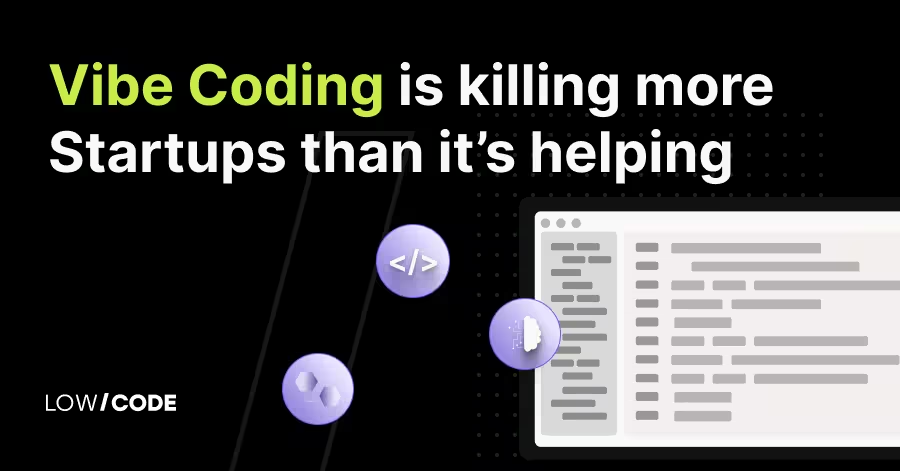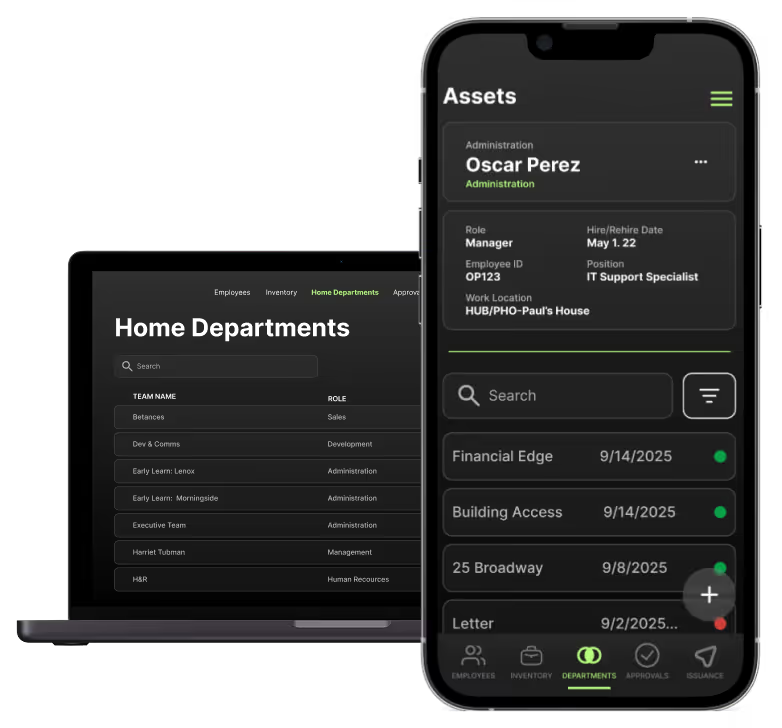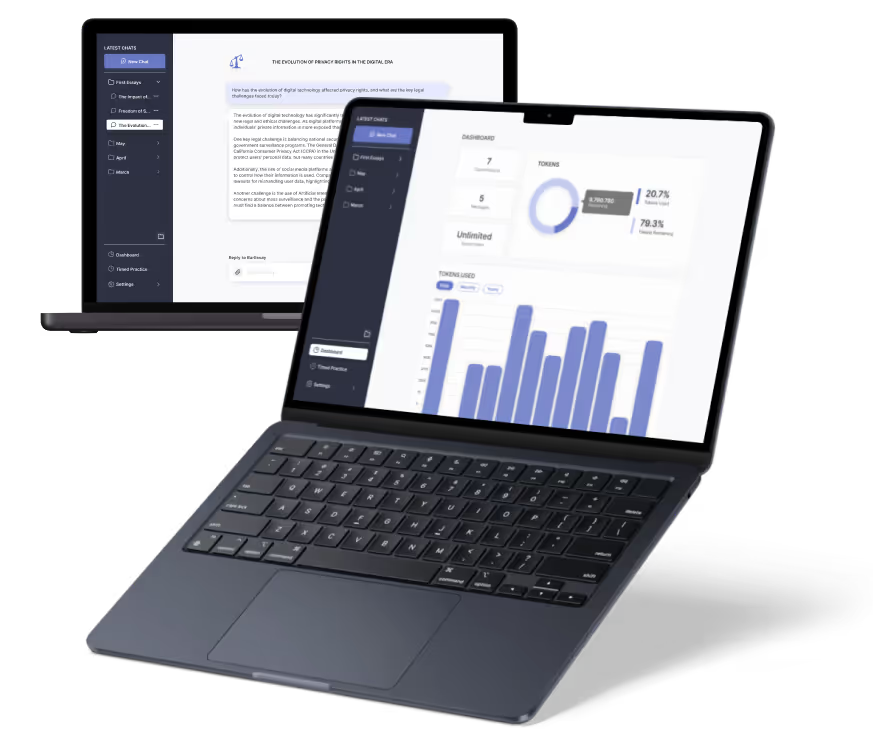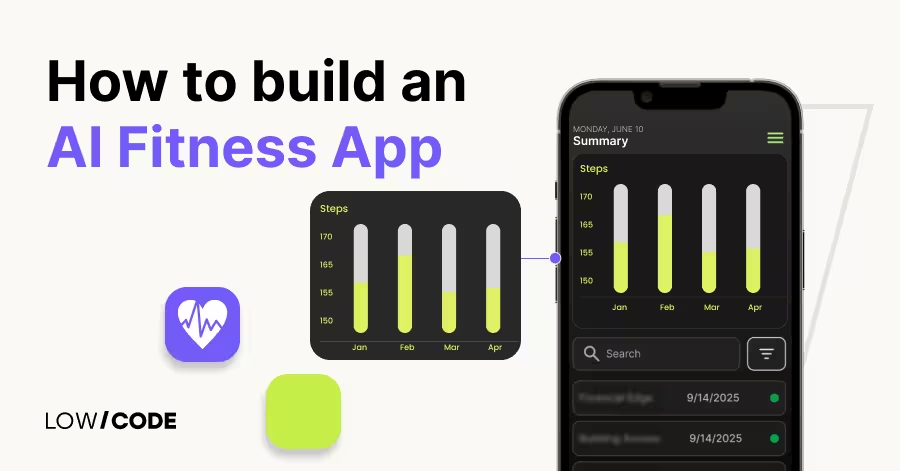Vibe Coding Is Killing More Startups Than It’s Helping
17 min
read
Discover why vibe coding is hurting more startups than it helps. Learn its hidden risks and why no-code/low-code offers a smarter, scalable alternative

The Rise of Vibe Coding
Vibe coding is the practice of using large language models (LLMs) to generate code with little to no review. Many startups embraced it as a shortcut to building products faster without traditional engineering overhead.
- Vibe coding means prompting AI tools to produce code without detailed planning or structured testing
- It gained popularity because the founders wanted speed, lean teams, and quick MVP launches
- The model promised reduced costs and faster iteration compared to traditional coding practices
Although appealing at first, this approach often creates fragile products and long-term technical debt.
Why Startups Are Falling for Vibe Coding
- Lower entry barrier, skip hiring engineers: You can build an entire MVP without posting a single job listing on AngelList. No more competing for scarce senior talent or dealing with equity negotiations. Just you, your laptop, and an AI that never asks for vacation time.
- Fast prototyping and quick demos: Need a working prototype for tomorrow's investor meeting? Vibe coding delivers functional demos in hours, not weeks. You can iterate on features faster than traditional development cycles and show tangible progress to stakeholders almost immediately.
- Perceived cost savings with lean teams: Why burn through your seed funding on developer salaries when AI can handle the heavy lifting? You're looking at subscription costs instead of six-figure payrolls. The math seems simple: fewer people, lower overhead, more runway.
- Feels innovative by adopting AI early: Being an AI-first company positions you as forward-thinking and tech-savvy. You're not just building a product; you're pioneering the future of development. It's a compelling narrative that resonates with investors and customers alike.
- Backed by hype from influencers and media: Every tech podcast and LinkedIn post celebrates AI coding breakthroughs. When industry leaders praise AI-generated applications, it validates your approach. The success stories flood your timeline, making vibe coding feel like the obvious choice.
- Creative freedom without structure: No senior architect telling you "that's not how we do things here." You can experiment with wild ideas and unconventional solutions without bureaucratic gatekeeping. The creative possibilities feel limitless when AI becomes your coding partner.
- Useful for hackathons and fast pivots: When you need to completely rebuild your product direction, vibe coding lets you prototype new concepts overnight. It's perfect for testing multiple approaches quickly and finding what resonates with users before committing serious resources.
- Attractive VC pitch with trendy buzzwords: "AI-powered development" and "lean engineering" sound impressive in pitch decks. Investors love hearing about efficiency gains and modern approaches. It positions your startup as resourceful and technology-forward.
- Community success stories inspire adoption: Twitter is full of founders sharing their vibe coding wins – apps built in weekends, features shipped in days. These viral success stories make the approach seem not just viable but necessary for competitive advantage.
- Comfort for non-tech founders: Finally, you can speak the same language as your product. No more feeling helpless when technical decisions arise. Vibe coding democratizes development, giving non-technical founders direct control over their vision.
Read more | AI App Development Guide
The Harsh Reality – Why Vibe Coding Fails Most Startups
Accumulating Technical Debt
Vibe coding produces quick code without long-term thinking. This leads to messy structures, duplicated logic, and shortcuts that pile up as technical debt. Over time, fixing these issues becomes more expensive than building correctly from the start.
Startups that ignore this debt often struggle to scale, as the foundation of their product cannot support advanced features or higher user loads. What seemed fast at first quickly turns into a drag on speed and growth.
Read more | AI Business Trends and Challenges
Security Vulnerabilities and Hidden Bugs
When code is generated with minimal oversight, security takes a back seat. Vibe-coded applications often ship with hidden bugs, weak authentication, or poor data handling. These vulnerabilities expose startups to breaches, compliance failures, and legal risks.
Unlike tested and reviewed code, vibe coding lacks thorough checks, leaving flaws unnoticed until they cause real damage. For startups, one security breach can break user trust permanently, costing both money and reputation. Speed means nothing if users cannot rely on the product’s safety.
Read more | AI Contract Management
Poor Maintainability and Onboarding Issues
Code created without structure or standards is hard to maintain. New team members struggle to understand inconsistent naming, unclear logic, and missing documentation. Onboarding slows down as engineers waste time deciphering what AI-generated code was trying to do.
Over time, simple feature changes take longer and cost more. Without clean architecture and maintainable practices, the startup’s velocity drops instead of improving. What started as a shortcut becomes a barrier, pushing teams into costly rewrites or complete rebuilds.
Read more | Can You Build an AI SaaS with No-code?
Scalability Problems Beyond MVP Stage
Vibe coding may work for a demo or MVP, but products often break when user demand grows. Poorly structured databases, unoptimized queries, and weak architecture cannot handle scale. Startups face downtime, crashes, and angry customers just as they begin to grow.
Scaling requires foresight in design, but vibe coding prioritizes quick wins. This short-term mindset creates long-term roadblocks. Startups that fail to plan for scalability end up rebuilding from scratch—losing precious time in competitive markets.
Read more | How to build a FlutterFlow AI-powered app
Inconsistent Team Collaboration
Vibe coding is often a one-person activity, driven by founders or small teams. Without coding standards or processes, collaboration becomes messy. Developers cannot easily align on features or understand why code works the way it does. This lack of consistency creates silos and communication gaps.
Teams spend more time fixing misunderstandings than building features. In the long run, inconsistent collaboration erodes morale and productivity. A product may launch quickly, but sustaining teamwork becomes an uphill battle.
Read more | How to build an AI agent in Slack
Investor Skepticism and Lack of Differentiation
Investors look for products with strong foundations. When they learn a startup’s product was cobbled together with vibe coding, confidence drops. Shaky architecture and lack of defensibility make it harder to raise capital. Investors fear future scaling costs and instability.
Additionally, vibe-coded products often look generic, since many startups are using the same AI-driven shortcuts. Without technical depth or unique differentiation, startups struggle to stand out in competitive markets, making funding and survival far more difficult.
Read more | How to build an AI project manager app using no-code
Non-Technical Founders Hit Scaling Walls
Non-technical founders see vibe coding as a way to build without engineers. It works for MVPs, but when complexity rises, they hit walls. Debugging errors, scaling infrastructure, and integrating advanced features require skills that AI alone cannot provide.
At this stage, teams must hire developers to rebuild large portions of the app. This transition costs time and money, often catching founders unprepared. Instead of speeding growth, vibe coding delays it, forcing startups into technical catch-up mode at the worst possible moment.
Read more | How to hire AI app developers
Loss of Engineering Craftsmanship
Software is not just about functionality; it’s also about craftsmanship. Experienced engineers build with maintainability, performance, and clarity in mind. Vibe coding skips these principles, creating code that works but lacks quality.
Over time, this erodes engineering culture, making teams dependent on quick hacks instead of strong practices. Startups lose the opportunity to develop a culture of excellence, which is essential for scaling teams. The lack of craftsmanship creates brittle products that fail when pressure mounts.
Read more | How we build an AI-powered app with Bubble
Over-Abstraction and Unpredictability
LLMs often produce layers of unnecessary abstraction, making code harder to understand or debug. Developers waste hours untangling logic generated without context. This unpredictability makes it risky to rely on AI for production-level systems. Features may work in testing but fail under real-world use.
Over time, this unpredictability frustrates teams, erodes trust in the product, and slows velocity. Startups discover that instead of accelerating development, vibe coding introduces uncertainty that undermines stability and long-term growth potential.
Read more | Best no-code AI app builders
Misrepresented AI Contributions
Startups using vibe coding often exaggerate what AI has achieved. Investors and stakeholders may believe the product is more stable or scalable than it really is. This misrepresentation creates trust issues once problems surface. Over-promising based on AI’s output damages credibility.
A lack of transparency around AI contributions can also complicate acquisitions or partnerships. In the end, startups that misrepresent their technical foundation risk both reputation and financial opportunities, leaving them weaker than competitors who build honestly and sustainably.
Read more | Build AI-Powered Mobile Apps
Vibe Coding as DIY—Fine for Hobby, Risky for Business
For hobby projects or quick prototypes, vibe coding can be useful. It helps test ideas fast and cheaply. But when real users, money, and growth are involved, relying on vibe coding becomes a serious liability. Businesses need reliability, security, and scalability – qualities Vibe Coding rarely provides.
Treating a startup like a weekend project sets it up for failure. While DIY experimentation is fine for learning, startups require professional engineering standards. Without them, vibe coding stops being an advantage and becomes a risk multiplier.
Read more | AI business process automation guide
The Bigger Risks Nobody Talks About
Cognitive Debt and Skill Erosion in Teams
Vibe coding may feel efficient, but over-reliance on AI erodes critical problem-solving skills. Teams lose the ability to design systems with intent and discipline.
- Engineers skip best practices and rely only on AI prompts
- Documentation and structured thinking decline over time
- Onboarding becomes harder as knowledge gaps widen
This skill erosion creates long-term cognitive debt, leaving startups less capable of handling growth.
Legal and Compliance Risks (Privacy, Audits, Regulations)
Compliance is non-negotiable in industries like healthcare, fintech, and real estate. Vibe coding often produces code that ignores legal standards.
- GDPR and HIPAA rules may be bypassed
- Audit trails and data-handling protocols get overlooked
- Violations expose startups to lawsuits and heavy fines
Without oversight, startups risk compliance failures that can cripple credibility and finances.
The False Sense of Progress (“Demo-ware Trap”)
Vibe coding produces fast demos, but shiny front-ends often hide weak back-ends. Startups confuse appearances with real progress.
- MVPs look polished but lack scalability and reliability
- Investors and users are misled by surface-level functionality
- Products collapse once real traffic or complexity is introduced
This “demo-ware trap” creates wasted effort and delayed growth.
Vendor Lock-In and Tool Dependency
Depending too much on AI vendors or single tools makes startups fragile. If the vendor changes terms, costs, or shuts down, products break.
- Migrating away from locked-in systems is expensive
- Dependence reduces flexibility and innovation
- Investors see vendor reliance as a long-term risk
True resilience comes from owning the architecture, not renting it from unpredictable providers.
Read more | AI fitness app development guide
Traditional Development Is Not the Answer Either
While vibe coding introduces risk, traditional development also creates serious challenges for startups. Its process-driven nature often makes it unsuitable for founders who need to move fast and validate ideas early.
- Slow and expensive
Building an app traditionally can take 6–12 months and cost $100k–$300k or more. Startups burn cash before testing product-market fit. - Resource-heavy requirements
Traditional models demand large engineering teams, project managers, and QA specialists. This adds management overhead and reduces flexibility for lean startups. - Overbuilt for early needs
Codebases are often structured for enterprise scale, not MVPs. Founders end up with bloated features and infrastructure they don’t yet need.
Traditional development may work for mature companies, but for startups, it slows iteration and risks running out of time or capital before product validation.
Read more | No-code Agency vs traditional Agency
The Smarter Alternative – No-code/low-code Development
Startups don’t need to choose between the fragility of vibe coding and the slowness of traditional development. No-code/low-code development provides a balanced approach: fast enough for MVPs, structured enough for long-term growth, and affordable enough for early-stage founders.
- Faster and cheaper than traditional dev: Deploy functional applications in weeks, not months, while avoiding the overhead of large engineering teams and lengthy planning cycles.
- Safer, more maintainable, and more structured than vibe coding: Built-in security measures, consistent architecture patterns, and visual workflows that any team member can understand and modify.
- Scalable apps with strong foundations: Platforms like Bubble, FlutterFlow, and Glide handle infrastructure scaling automatically while maintaining performance under real-world load conditions.
- AI-ready, designed for long-term use: Modern no-code platforms integrate seamlessly with AI services and APIs, letting you add intelligent features without architectural compromises.
- Proven in startups, SMBs, and enterprise operations: Companies across all stages use these platforms successfully, from early-stage MVPs to enterprise applications serving millions of users.
Read more | Healthcare App Development Guide
Why Work with LowCode Agency
At LowCode Agency, we’re not just another development shop delivering code—we act as your dedicated product team. We challenge assumptions, refine requirements, and suggest better approaches to ensure every decision supports your long-term business goals.
Our involvement extends beyond building features; we serve as strategic partners, guiding you from concept to scaling.
- Proven expertise: Largest Glide agency worldwide, Bubble silver partner, and FlutterFlow specialists.
- Track record: Over 350 applications built across industries.
- Platform agnostic: We recommend the right tool for your needs, not a one-size-fits-all solution.
- Selective partnerships: We take on fewer projects to ensure deep focus and transformational results.
By combining technical skill with strategic guidance, we help founders build sustainable, scalable businesses – not fragile prototypes that collapse under pressure.
Read our case studies to learn about the solutions we can build for various industries.
Conclusion – Build Smart, Not on Vibes
Vibe coding may deliver speed, but it creates fragile products that sink more startups than they save. Traditional development, on the other hand, is often too slow, costly, and resource-heavy for early-stage founders.
The smarter path is no-code/low-code, a balance between speed, quality, and scalability. It empowers startups to launch quickly, validate ideas, and scale without sacrificing structure or security.
If you’re serious about building something real, Let’s talk and find out how the right development approach can turn your vision into reality.
Created on
October 6, 2025
. Last updated on
November 18, 2025
.

FAQs
What is vibe coding in startups?
Why is vibe coding risky for new businesses?
Can vibe coding scale beyond an MVP?
How does vibe coding compare to traditional development?
Is no-code/low-code a better option than vibe coding?
How can LowCode Agency help startups build smarter products?









%20(Custom).avif)








